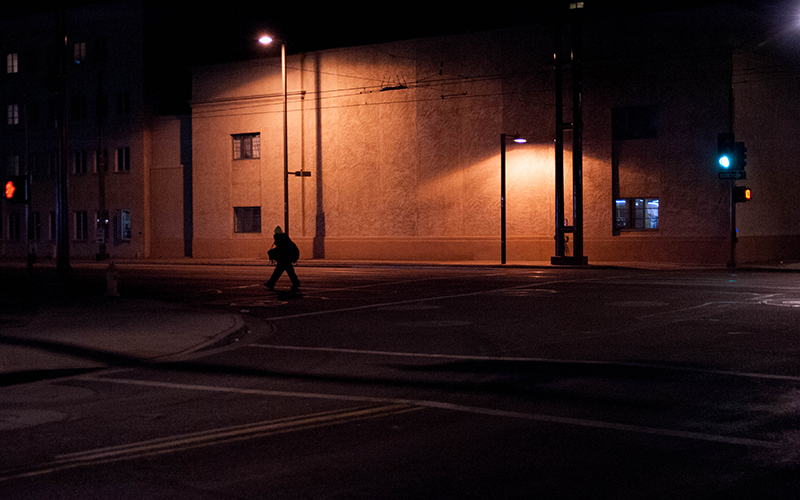LOS ANGELES – Living on the streets isn’t just dangerous. It’s deadly, a new study finds.
Older people who live in homeless shelters, encampments or without traditional housing are 3.5 times more likely to die prematurely compared with those who have a roof over their heads, reports the August study from the University of California, San Francisco.
The findings were based on a survey of 450 men and women 50 and older who were experiencing homelessness in Oakland, Calif., that was conducted over eight years and ended in December.
Of those, 117 died at a median age of 64.6 years. The Centers for Disease Control and Prevention recently reported that life expectancy in the U.S. was 76.1 years in 2021.
“It’s really upsetting that we have older people who are living out on the streets, and particularly when we know that people who become homeless later in life are at increased risk,” said Dr. Rebecca Brown, UCSF affiliated assistant professor of medicine in the division of geriatrics, “I think it does point to the importance of prevention.”
Brown served as co-investigator in the study, which was led by Dr. Margot Kushel, director of the UCSF Center for Vulnerable Populations.
Their work has focused on understanding how geriatric conditions affected older adults experiencing homelessness. The research found that individuals experiencing homelessness have a higher prevalence of developing geriatric conditions sooner than the general population.
The finding that premature death is 3.5 times more likely to occur is based on a comparison with those of similar ages in the Oakland area.
Of the 117 fatalities, the leading causes were heart disease and cancer, each at 14.5% of the total, followed by drug overdoses at 12%.
The study involved conducting telephone or in-person check-ins every month or every six months, offering $5 compensation for each interview. The check-ins included details such as housing status and self-rated health status.
“It’s kind of like a moral imperative,” Brown said.
Brown said the research shows a greater need for policy reform and intervening to help people experiencing homelessness to lower the death count. Solutions include finding housing for people as soon as they become unhoused and providing permanent supportive homes over the long term.
“I think the study builds the evidence of how horribly bad it is to be homeless and an older adult, and how we need to prevent and end homelessness in this age group,” Brown said.
Though the study focused on Oakland, Homelessness has become is a nationwide problem.
In Maricopa County, Central Arizona Shelter Services, known as CASS, serves as the largest and longest serving homeless emergency shelter provider in the state. CASS expects to report a 7.5% increase in homelessness among the elderly in September and October 2021, according to Richard Southee, program success manager.
CASS does not track the outcomes of unsheltered clients, Southee said, and can’t accurately gauge the mortality rate after clients leave shelters. However, the organization acknowledges that seniors are an especially vulnerable group within the unhoused population.
Seniors most likely to fall into homelessness include those who lack a safety net of extended family or friends who can help them out in tough times. People with disabilities are especially vulnerable.
“They have less security and so they are more likely to experience homelessness,” Southee said. “And I think in Arizona it’s particularly hard.”
That’s because unhoused people in Maricopa County have more difficulty contacting family and securing services in such cities as Tucson or Flagstaff, due to the distances involved and the lack of transportation options.
Data published in the UCSF study allows CASS to assess their own work and help contribute to the goal of policy reform to benefit and aid older populations experiencing homelessness. It assists agencies in knowing where to find unhoused people and try to intervene before their health problems become fatal.
“I think it speaks to a need for more data sharing,” Southee said.
In Los Angeles, the Rev. Andy Bales, president of one of the city’s most prominent private shelters, the Union Rescue Mission, works to aid unhoused people throughout the city.
Much of his work involves caring for and providing permanent supportive housing and medical attention for all ages experiencing homelessness.
Over the past 36 years, Bales said, he has dealt with numerous cases of elder individuals experiencing homelessness and witnessed countless numbers of deaths. Many were caused by preexisting heart conditions, cancer or lack of access to or neglect from hospitals, he said.
“We save a lot of lives by welcoming in anyone who comes to our door,” Bales said. “But even when we welcome people, the time on the streets has taken a lot out of them.”
He said people on the streets are suffering and dying at an alarming rate.
“I can remember a couple years ago, there were only three (deaths) per day. It just keeps getting worse and not better,” Bales said. The New York Times reported in April that Los Angeles County now averages about five deaths of homeless people each day.
To deal with what Bales calls a “population boom of older adults,” the mission plans to double senior housing at its Hope Gardens Family Center, where seniors and others get a single-occupancy room with a bathroom, meals and security, as well as medical and legal referrals. It also provides access to such amenities as a library, computers, a living/community room and a kitchen.
“The sheer number of seniors who are coming” will overwhelm the shelter community, Bales said, “if we don’t prepare to make sure we address homelessness in senior years.”

